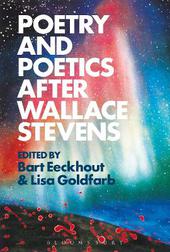
|
Poetry and Poetics after Wallace Stevens
Hardback
Main Details
| Title |
Poetry and Poetics after Wallace Stevens
|
| Authors and Contributors |
Edited by Dr Bart Eeckhout
|
|
Edited by Professor Lisa Goldfarb
|
| Physical Properties |
| Format:Hardback | | Pages:288 | | Dimensions(mm): Height 229,Width 152 |
|
| Category/Genre | Literary studies - from c 1900 -
Literary studies - poetry and poets |
|---|
| ISBN/Barcode |
9781501313486
|
| Classifications | Dewey:811.52 |
|---|
| Audience | | Undergraduate | | Postgraduate, Research & Scholarly | |
|---|
| Illustrations |
2 b/w illustrations
|
|
Publishing Details |
| Publisher |
Bloomsbury Publishing Plc
|
| Imprint |
Bloomsbury Academic USA
|
| Publication Date |
17 November 2016 |
| Publication Country |
United States
|
Description
As the figure of Wallace Stevens (1879-1955) becomes so entrenched in the Modernist canon that he serves as a major reference point for poets and critics alike, the time has come to investigate poetry and poetics after him. The ambiguity of the preposition is intentional: while after may refer neutrally to chronological sequence, it also implies ways of aesthetically modeling poetry on a predecessor. Likewise, the general heading of poetry and poetics allows the sixteen contributors to this volume to range far and wide in terms of poetics (from postwar formalists to poets associated with various strands of Postmodernism, Language poetry, even Confessional poetry), ethnic identities (with a diverse selection of poets of color), nationalities (including the Irish Nobel Laureate Seamus Heaney and several English poets), or language (sidestepping into French and Czech poetry). Besides offering a rich harvest of concrete case studies, Poetry and Poetics after Wallace Stevens also reconsiders possibilities for talking about poetic influence. How can we define and refine the ways in which we establish links between earlier and later poems? At what level of abstraction do such links exist? What have we learned from debates about competing poetic eras and traditions? How is our understanding of an older writer reshaped by engaging with later ones? And what are we perhaps not paying attention to-aesthetically, but also politically, historically, thematically-when we relate contemporary poetry to someone as idiosyncratic as Stevens?
Author Biography
Bart Eeckhout is Professor of English and American Literature at the University of Antwerp, Belgium. He is editor of The Wallace Stevens Journal, author of Wallace Stevens and the Limits of Reading and Writing (2002), and co-editor of Wallace Stevens across the Atlantic (2008), Wallace Stevens, New York, and Modernism (2012), and five special issues of The Wallace Stevens Journal. Lisa Goldfarb is Associate Professor at New York University's Gallatin School of Individualized Study, USA. She is President of The Wallace Stevens Society, Associate Editor of The Wallace Stevens Journal, author of The Figure Concealed: Wallace Stevens, Music, and Valeryan Echoes (2011), and co-editor of Wallace Stevens, New York, and Modernism (2012) and two special issues of The Wallace Stevens Journal.
ReviewsA landmark work of scholarly and editorial imagination. In this probing, often dazzling, and clearly transformative volume, we encounter a Stevens whose reverberant afterlives are many, various, and complex. In its ambition and its willingness to embrace discrepancy and disjunction, this volume breaks new ground for hearing and counter-hearing Stevens into the 21st century. Whether resonating in England or unremarked in Czechoslovakia; a disaster for American poetry or its richest resource; surrealist, symbolist, or ordinary; embraced or critiqued, assimilated or expelled: Stevens emerges as a vibrant, paradoxical, protean force in 20th and 21st century poetics. This book will appeal to anyone interested in Stevens, in the ghostlier as well as keener demarcations of his legacy, and in the legacy of Modernism tout court. * Maureen McLane, Professor of English, New York University, USA, and author of My Poets * This stimulating collection of essays shows how, far from being a 'silent man,' Stevens has been part of a 'continual conversation' with later American poetry: in doing this, it extends our sense of Stevens as well as of the more contemporary poetic scene. Roethke paid him the tribute, 'Brother, he's our father!', but contributors to this book suggest that, both approvingly and adversarially, his work has also engaged the sisterhood. These essays significantly enlarge our understanding of Stevens, his successors, and models of literary influence. * Tony Sharpe, Senior Lecturer in English, Lancaster University, UK, and author of Wallace Stevens: A Literary Life * This collection features established Stevens scholars writing about Stevens's influence on later poets, but it is not a systematic study of 20th-century poetry. Yet Eeckhout and Goldfarb's approach yields some rewards: a more conventional history would hardly consider Seamus Heaney as a vehicle of Stevensian influence, but George Lensing does that in his contribution and finds that, despite their differing attitudes towards abstraction, Stevens and Heaney had a shared sense of peace and harmony. Lisa Steinman takes one from unlikely readers of Stevens to unanticipated readers in her discussion of African American poet C. S. Giscombe, whose work unearths implications of Stevens not contemplated by the poet himself or his initial readers. Few poets today would deliberately style themselves as Stevensian, yet, as Rachel Malkin shows in her essay on Robert Hass, even "an esthetic of the ordinary" is haunted by Stevens's reflexive modernism ... Charles Altieri's essay on Stevens and John Ashbery is scholarly and magisterial. And in fact most of the essays operate to convince the reader that-as Goldfarb puts it in her contribution, "Stevens' Musical Legacy: 'The Huge, High Harmony'"-there is "a vibrancy that is palpable in the work of ... many contemporary poets." Summing Up: Recommended. * CHOICE *
|